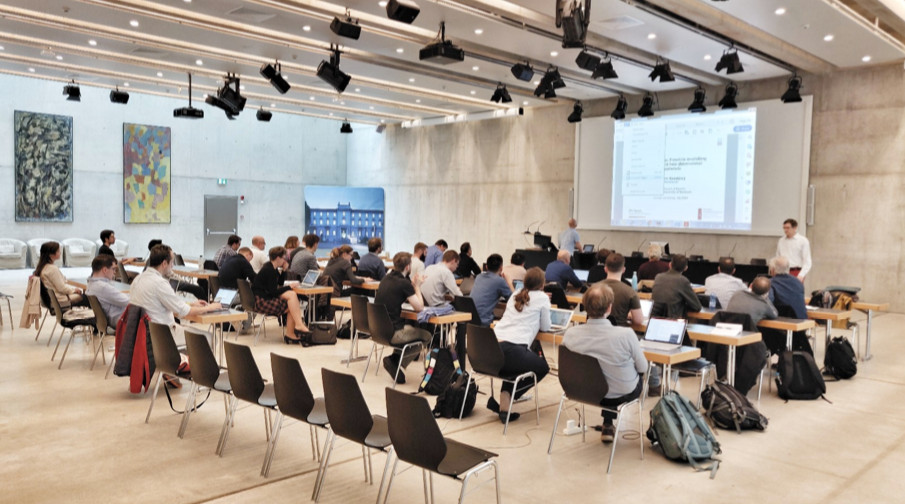Joint Psi-K / CECAM workshop: Electron-phonon coupling: Computational methods for electronic transport in nanostructures and in bulk materials
Dates: 14-16. October 2019
Location: USI Lugano, Switzerland
During 3 hectic days in October 2019, 25 researchers from different specialties meet in Lugano to discuss and learn about electron-phonon coupling. The purpose of the workshop was explicitly to foster collaboration between researchers in the following fields:
- Real-life performance of semiconductors and metals, whether it be in one, two, or three dimensions, is often limited by carrier scattering by phonons. The mobility of charge carriers is a key parameter in the semiconductor industry to describe the electrical performance and the movement under applied electric fields. The traditional approach to calculate phonon-limited mobility is based on the Boltzmann transport equation in combination with the effective mass approximation and empirical deformation potentials. In recent years predictive parameter-free mobility calculations have been carried out at the density functional theory (DFT) level for the electron-phonon coupling (EPC).
- EPC may also lead to a Bose-Einstein condensation of electrons near the Fermi surface as Cooper pairs, resulting in conventional superconductivity at sufficiently low temperatures or high pressures. Also here DFT calculations of EPC have explained the origin of superconductivity in a range of materials and provided quantitative estimates for the critical temperature using Migdal-Eliashberg theory. A recent example includes first-principles theory that revealed how high-pressure hydrogen sulfide is a strongly anharmonic superconductor.
- In a different context, the introduction of Inelastic Electron Tunneling Spectroscopy have opened up the possibility to study adsorbates and molecular junctions and to characterize inelastic scattering against vibrations down to the single-molecule limit. Ab-initio approaches based on DFT and nonequilibrium Green’s functions (NEGF) have been developed to describe the EPC in such nanoscale junctions and to explain the inelastic transport characteristics.
Despite the common origin of EPC in these three distinct phenomena (phonon-limited resistivity, phonon-mediated superconductivity and IETS) the systems have traditionally been considered separately by different researchers and with different ab initio methods. In this workshop we gathered researchers interested in such EPC physics from these three different communities using very different approaches, codes, and methods. This provided fruitful discussions where new ideas were inspired by the crossbreeding of the different communities.
The workshop contributed with talks and discussions within each of the three areas dealing with electron-phonon coupling. In addition, discussions on spin-relaxation and photocarrier thermalization arose which could well be considered as additional areas for discussion in future workshops.
Some key advances that was discussed at the workshop included:
- Recent advances in ab initio IETS theory including the extension to 2D delocalized phonons at interfaces, second-order processes of IETS at interfaces, and Monte Carlo approaches together with quantum transport calculations compared with the Boltzmann transport equation.
- The importance of anharmonicity in the contexts of phase transitions, charge-density waves, and stabilization of crystal structures was discussed. The role of the quantum nature of light-element atoms (in particular hydrogen) was exemplified for the new class of the high-pressure, high-temperature superconductors H3S and RhH11.
- Ab-initio modelling of EPC and electron mobility in 3D materials. A high throughput computational search for novel, never synthesized, high-mobility 2D materials was presented and discussed. One of the problems here is about how to deal with the computational complexities of the large number of k/q-points needed for 3D models. New ideas included the change of basis from k-space to symmetrized basis functions which capture most of the EPC on the Fermi-surface without the need for a complete basis. Also, a neural-network strategy for EPC trained with ab-initio data was presented, with perspectives that extrapolation to similar, but larger supercells may be possible. In addition, extension to the Boltzmann approximation was detailed.
- The role of EPC was further described in the relaxation of spin, important for spintronics and quantum computation devices. In addition, for photovoltaic applications the thermalization of the electron-hole excitation and separation of charges is driven by EPC.
The list of participants and the program can be found on the CECAM website.
Organisers:
Magnus Paulsson, Linnaeus University, Sweden
Thomas Frederiksen, DIPC – Donostia International Physics Center, Spain

